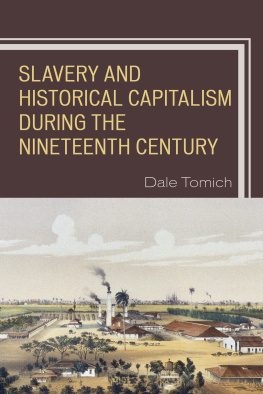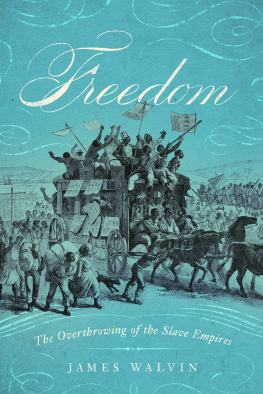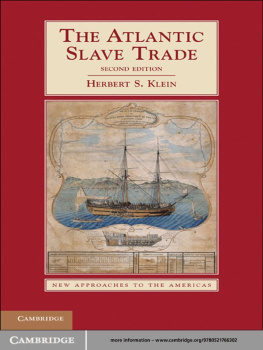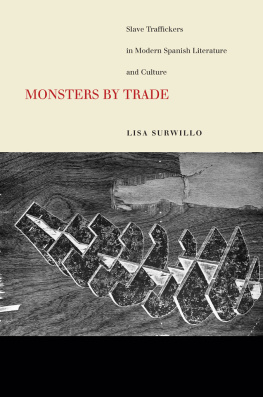Disease, Resistance, and Lies
DISEASE,
RESISTANCE,
AND LIES
The DEMISE of the TRANSATLANTIC SLAVE TRADE
to BRAZIL and CUBA
DALE T. GRADEN
LOUISIANA STATE UNIVERSITY PRESS
BATON ROUGE
Published by Louisiana State University Press
Copyright 2014 by Louisiana State University Press
All rights reserved
Manufactured in the United States of America
LSU Press Paperback Original
First printing
Designer: Barbara Neely Bourgoyne
Typeface: Whitman
Printer and binder: Maple Press
Library of Congress Cataloging-in-Publication Data
Graden, Dale Torston, 1952
Disease, resistance, and lies : the demise of the transatlantic slave trade to Brazil and Cuba / Dale T. Graden.
p. cm.
Includes bibliographical references and index.
ISBN 978-0-8071-5529-5 (pbk. : alk. paper) ISBN 978-0-8071-5530-1 (pdf) ISBN 978-0-8071-5531-8 (epub) ISBN 978-0-8071-5532-5 (mobi) 1. Slave tradeBrazilHistory19th century. 2. Slave tradeCubaHistory19th century. 3. Slave insurrectionsBrazilHistory19th century. 4. Slave insurrectionsCubaHistory19th century. 5. SlavesHealth and hygiene. 6. EpidemicsHistory19th century. I. Title.
HT1127.G69 2014
306.3'6209729101034dc23
2013039453
Portions of this text were previously published as:
An Act Even of Public Security: Slave Resistance, Social Tensions, and the End of the International Slave Trade to Brazil, 18351856, Hispanic American Historical Review 76, no. 2, 24982. Copyright 1996, Duke University Press. Reprinted by permission of the publisher.
Interpreters, Translators and the Spoken Word in the Trans-Atlantic Slave Trade to Cuba and Brazil, Ethnohistory 58, no. 3, 393413. Copyright 2011, Duke University Press. Reprinted by permission of the publisher.
O envolvimento dos Estados Unidos no comrcio transatlntico de escravos para o Brasil, 18401858, Afro-sia, no. 35, 935. Copyright 2007, Federal University of Bahia. Reprinted by permission of the publisher.
Slave Resistance and the Abolition of the Trans-Atlantic Slave Trade to Brazil in 1850, Histria Unisinos 14, no. 3, 28283. Copyright 2007, University Vale do Rio dos Sinos, doi: 10.4013/htu.2010.143.05. Reprinted by permission of the publisher.
The paper in this book meets the guidelines for permanence and durability of the Committee on Production Guidelines for Book Longevity of the Council on Library Resources.

For Laura and Luisa
ACKNOWLEDGMENTS
Dear friends, caros amigos, what a journey it has been! I was born in Philadelphia and raised in Rhode Island, attended college in Boston, taught at a high school and attended graduate schools in Connecticut, and for the last two decades have resided in northern Idaho. A vivid memory from my early youth relates to a message in a bottle. When that bottle washed up on a Rhode Island shore, it set me thinking about faraway places and ocean tides. In many ways, I have been pondering the diverse currents of the Atlantic world ever since.
I have been fortunate to have had the opportunity to read widely. One book that has stayed with me is Kenneth M. Stampps The Era of Reconstruction, 18651877, which made an indelible impression in eleventh grade. That small volume sparked a desire to learn more about the history and cultures of the African Americas.
I have also been fortunate to have had some great (and patient!) teachers along the way, including Dale Conly, Richard D. Brown, Francisco A. Scarano, and the late Hugh M. Hamill Jr. and E. Bradford Burns.
Many scholars have shared their time, insights, and good spirits. Thanks to George Reid Andrews, Manuel Barcia, Seymour Drescher, Anani Dzidzienyo, Aisha Finch, Flvio Gomes, Lyman Johnson, Hendrik Kraay, Jane Landers, Leonardo Marques, Paulo Cesar de Oliveira, Eugenio Piero, Maria Ligia Prado, Ines Quintero, Matthew Restall, James Riordan, David Sheinin, Richard Spence, William Swagerty, Mark Warner, and Dick Wilson. I particularly want to express my appreciation to Joo Reis and David Eltis, both of whom responded always with gentileza to many questions over the years.
Thanks to the anonymous reviewers of the manuscript. Their comments were insightful and helpful.
The Fulbright Commissions of Brazil, Venezuela, and the United States, the Office of Research and Economic Development at the University of Idaho, and the UI Department of History all provided much appreciated funding.
Several individuals helped in the preparation of this manuscript. The maps were created by Christina Brewer, Andrea Villarroel, and Kevin Henry. The vessel lists and graph were constructed by Dirk Van Beek and Jeff Meyers. Eric Wright helped with organizing the endnotes. Many books, articles, and microfilms were found and requested through interlibrary loan by Jesse Thomas and Jennifer OLaughlin.
I could not ask more of an editor than Alisa Plant at LSU Press. She has been exceptional. Gary Von Euer provided invaluable assistance in the final preparation of the manuscript.
Thanks to the editors of Afro-sia (Salvador, Brazil), Historia Unisinos (So Leopoldo, Brazil), and Hispanic American Historical Review and Ethnohistory (both published by Duke University Press) for permission to include materials in this book that were previously published in those journals.
My parents were the offspring of four immigrants who crossed the Atlantic to the United States in the early twentieth century. They created many opportunities for my sister Beth Graden Rom, my brother Gary Graden, and me. They are missed.
This book is dedicated to Laura and Luisa, who have supported me in so many ways.
Disease, Resistance, and Lies
INTRODUCTION
Research on Atlantic history has flourished over the past two decades. With roots in studies published in the 1950s, it has provided multiple prisms to interpret comparative histories. Its umbrella enables one to trace the ties that bind international commerce, public health, and social history.
By 1800, the United States, Brazil, and Cuba played major roles in the Atlantic world. In each country, elites gained wealth from the sale of commodities produced by slaves. In the United States, cotton became king. Cotton production in the United States rose from 750 tons in 1790 to 18,300 tons in 1800 to approximately 1 million tons in 1860. Raw cotton represented more than one-half of all U.S. exports by the outbreak of the Civil War in 1861. New Englands 472 mills processed hundreds of millions of pounds of cotton from 1830 to 1860. Englands 2,650 cotton factories received more than half of all U.S. cotton exports.
In Brazil, coffee replaced sugar as its primary export. Although sugar exports increased from 20,000 tons in 1800 to 120,000 tons in 1850, profits were low. The value of sugar to the economy doubled between 1820 and 1870, considered to be a slow rate of growth. Between 1820 and 1835, the output of coffee jumped from 14,300 tons per year to 66,000 tons per year. This placed Brazil ahead of competitors producing coffee in Jamaica, Cuba, and Java.
Sugar became king in Cuba. In the words of Professor Louis A. Prez Jr., sugar cultivation expanded rapidly during the first half of the nineteenth century, and its expansion heralded the transformation of all of Cuba. Sugar represented 60 percent of total exports from Cuba in 1840 and 74 percent in 1860. During this period, coffee output declined due to two hurricanes, world competition, and a downturn in prices. Coffee exports dropped from 31,250 tons in 1833 to 6,992 tons in 1845 and 1,928 tons in 1867.








